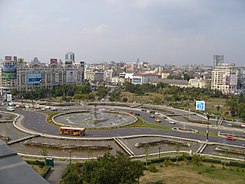Unification Square (Bucharest)
| Piața Unirii Unification Square |
|
|---|---|
| Place in Bucharest | |
 Unification place today |
|
| Basic data | |
| place | Bucharest |
| District | Unirii |
| Created | 1960 |
| Newly designed | 1984 |
| Hist. Names | Piața Mare |
| Confluent streets | Bulevardul Unirii, Bulevardul Dimitrie Cantemir, Splaiul Independentei etc. |
| Buildings | Rum. National Library |
Piața Unirii ( German Union Square or Unity Square ) is one of the largest squares in the center of the city of Bucharest and is located at the point where the districts 1 , 2 , 3 and 4 meet. It is crossed by Unirii Boulevard , originally named Boulevard of Victory of Socialism ( Calea Victoriei Socialismului ) during the socialist era , and only given its current name after the Romanian Revolution of 1989 .
description
The square is an important traffic junction. It has its own metro station ( Metro Piața Unirii ) and an important bus stop and several tram stops near the southwest corner. The Unirea Shopping Center , Cocor department store and a large taxi rank are on the east side of the square, while Gasthof Hanul lui Manuc is on the north side, near the northeast corner. The middle of the square offers a small park and a fountain, which is particularly popular with passers-by in the hot summer months. Plans to build the Cathedral of the People's Redemption on the square turned out to be unfeasible because of the nearby Dâmbovița .
history
Although the square no longer looks historic today, it used to be an important Romanian trading point.
19th century

At the beginning of the 19th century, traders from all parts of Wallachia were gathering in front of the Hanul lui Manuc restaurant to sell their goods. When Bucharest expanded south of the Dâmbovița, a large market developed there, as the name suggests ( Piața Mare ). The market became more and more popular because over time there were even traders from Moldova , Transylvania and Bulgaria . In order to ensure a better overview of the goods, the market was divided into categories in 1831, each of which could have its own covered department store built over time. So came about:
- 1831: Hala Mare (the meat market, also Hala Centrală or Hala Ghica );
- 1874: Piața Bibescu (uncovered vegetable market);
- 1883: Hala de fructe (the fruit market);
- 1885: Hala de flori (the flower market);
- 1887: Hala de peşte (the fish market);
- 1899: Hala de păsări (the poultry market)
This market complex later received the official name of Union Halls ( Halele Unirii )
Halele Unirii at the time of socialism
From 1960 the socialists began to plan a civic center ( Centrul Civic ). This was intended to replace important parts of the historic city center of Bucharest , including the hall district. But they proceeded very slowly and unnoticed:
- 1960: The Hala de flori is demolished;
- 1964: Large parts of the Piața Bibescu vegetable market are demolished;
- 1971: The Dâmbovița is covered in the center by a concrete layer;
- 1975: The Bulevardul Anul is built right through the city center in 1848 through a road breakthrough , 1/5 of the city center is razed to the ground, including Hala de păsări and Bazaca Street .
- 1982: All halls except for the large hall are demolished to make way for the Centrul Civic , and the Spitalul Brâncovenesc is also demolished.
- 1983: More road breaks take place: Bulevardul Unirii , Bulevardul Dimitrie Cantemir , Bulevardul Corneliu Coposu etc.
- 1985: Hala Mare is the last to be demolished; it has to give way to the park on Piața Unirii .
literature
- Birgitta Gabriela Hannover: Bucharest. On the way in the Romanian metropolis, Tescher Verlag 2008, ISBN 978-3-89794-120-5
Web links
- Baedeker Travel Guide , Anne Kotzan: Romania
- Eastern Europe , Ceaușescus Bucharest, page 627 (English)
- Bucureștii Vechi și Noi , Halele Unirii (Romanian)
- Harta Bucuresti , Piața Unirii on the city map of Bucharest
Coordinates: 44 ° 25 ′ 40 ″ N , 26 ° 6 ′ 9 ″ E
